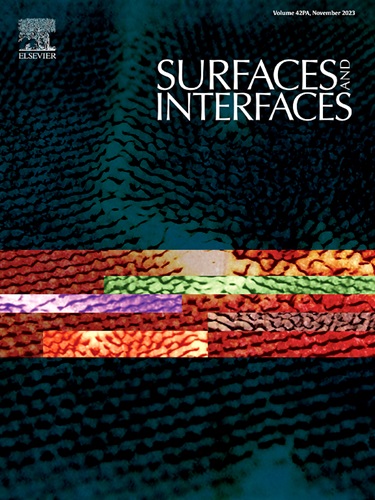Resistive Switching in CaF2-MoS2 Nanocomposite thin films for low energy memory and neuromorphic applications
IF 5.7
2区 材料科学
Q2 CHEMISTRY, PHYSICAL
引用次数: 0
Abstract
Cognitive computing paradigm is an innovative field of research contrary to the conventional methods, seeking inspiration from human brain. The limitations of von Neumann architecture can be overcome by replacing the conventional computer architecture with artificial synapse-based techniques that are inspired by human brain composed of neurons and synapses. In this study, we report the fundamental synaptic performance of CaF2-MoS2 nanocomposite film. The electronic conduction exhibited by the Al/CaF2-MoS2/Al device is attributed to via the charge trapping and detrapping at the interface. The device can be operated with low energy consumption/spike ( nJ) that varies linearly with the voltage pulse width. Device exhibits excellent synaptic functionalities with stable potentiation and depression curves lasting multiple cycles. Each potentiation and depression curve can be fitted with a bi-exponential function indicating two dominant processes affecting synaptic current. Further the synaptic amplification can be tuned by using voltage pulses of different frequencies. Spike rate dependent plasticity (SRDP) shows a cut-off frequency beyond which the synaptic amplification occurs in the devices. This work proposes a new avenue for CaF2 based artificial synaptic device which can be utilized for multifunctional applications in future. The work also details the importance of tuning various parameters for electrical stimulation such as pulse voltage and pulse width to get optimum performance of artificial synapse in such nanocomposite based devices.

用于低能耗存储器和神经形态应用的 CaF2-MoS2 纳米复合薄膜中的电阻开关
认知计算范式是一种与传统方法相反,从人脑中寻求灵感的创新研究领域。冯·诺伊曼架构的局限性可以通过用基于人工突触的技术取代传统的计算机架构来克服,这种技术的灵感来自于由神经元和突触组成的人脑。在这项研究中,我们报道了CaF2-MoS2纳米复合膜的基本突触性能。Al/CaF2-MoS2/Al器件表现出的电子传导是通过在界面处的电荷捕获和脱陷来实现的。该器件可以在低能耗/尖峰(~ nJ)下工作,其随电压脉冲宽度线性变化。该装置具有良好的突触功能,具有稳定的增强和下降曲线,可持续多个周期。每个增强和下降曲线都可以用双指数函数拟合,表明影响突触电流的两个主要过程。此外,可以通过使用不同频率的电压脉冲来调节突触放大。脉冲速率依赖的可塑性(SRDP)显示出一个截止频率,超过这个频率,突触放大就会发生在器件中。这项工作为基于CaF2的人工突触装置提供了一条新的途径,可以在未来用于多功能应用。这项工作还详细说明了调整各种电刺激参数(如脉冲电压和脉冲宽度)的重要性,以便在这种基于纳米复合材料的设备中获得最佳的人工突触性能。
本文章由计算机程序翻译,如有差异,请以英文原文为准。
求助全文
约1分钟内获得全文
求助全文
来源期刊

Surfaces and Interfaces
Chemistry-General Chemistry
CiteScore
8.50
自引率
6.50%
发文量
753
审稿时长
35 days
期刊介绍:
The aim of the journal is to provide a respectful outlet for ''sound science'' papers in all research areas on surfaces and interfaces. We define sound science papers as papers that describe new and well-executed research, but that do not necessarily provide brand new insights or are merely a description of research results.
Surfaces and Interfaces publishes research papers in all fields of surface science which may not always find the right home on first submission to our Elsevier sister journals (Applied Surface, Surface and Coatings Technology, Thin Solid Films)
 求助内容:
求助内容: 应助结果提醒方式:
应助结果提醒方式:


